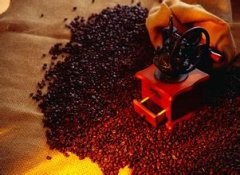A brief introduction to the history and culture of the origin and development of Dominican boutique coffee

Boutique coffee has become popular in recent years. High-quality coffee beans produced by some Dominican estates have a rich aroma, mellow taste and moderately bright sour taste, which are not far from the more famous Puerto Rico beans or Jamaican beans, and are also worth tasting. Dominica coffee beans have moderate acidity and rich fruit flavor.
In the western part of Hispaniola, harvested in the mountains above 1500 meters above sea level, the rich coffee Republic of Dominica (Dominican Republic) is adjacent to Haiti, both of which own the island of Hispaniola (Hispaniola). The best place to produce is the Barahona region in the southwest, but Juncalito and Ocoa also produce a fine coffee, Santo Domingo coffee, which is characterized by freshness and elegance, fullness, excellent acidity and pleasant aroma, so it is worth it. Unlike the coffee produced in Haiti, most of the coffee grown in the Dominican Republic is washed, which is also a symbol of high quality. Unlike coffee produced in Haiti, most coffee grown in the Dominican Republic is washed. This is also a symbol of high quality. Miniga Coffee uses a washing method to treat coffee beans, so that the quality of treated coffee beans is more guaranteed. The coffee beans treated by washing method retain more original flavor than the drying method, and the aroma is pure and soft.
Carefully selected in this way, the high-quality coffee of Dominica exudes a faint aroma and gives people a faint fruity aroma with a lingering finish and a smooth and smooth finish.
At the beginning of the 17th century, when French, Dutch and British pirates were operating in the west of Hispaniola, France began to allow farmers and merchants to gradually colonize the western part of the Spanish island, which was blocked by mountains on the island. It didn't attract the attention of the Spaniards in the east. [3]
In 1677, about 4,000 French lived in 11 villages in the west of the island. In 1697, France and Spain ceded the western part of the island to France according to the Leswick Treaty of the Alliance War, formally recognizing French sovereignty over Haiti in the western part of the Spanish island, and the eastern part of the Spanish island was called East Santo Domingo. With the continuous development of French agricultural economy on the island of Hispaniola and the introduction of African slave farming, Haiti became a very productive French colony at the end of the 18th century, when the population of Haiti reached more than 500,000. At this time, blacks accounted for nine out of every ten Haitians, making up the majority race. The population of the Spanish colony of Santo Domingo in the southeast is 150000, and the proportion of the two places is quite different. [3]
In 1700, the Bourbon dynasty replaced the Habsburg dynasty in Spain. The new dynasty introduced some economic reforms. Trade in Santo Domingo began to flourish. [3]
French rule (1795-1809)
In 1795, France and Spain signed the Basel Peace Treaty in Switzerland, agreeing to transfer Spain
Dominica
Dominica
The Santo Domingo region in the east of the island was ceded to France, making the Spanish island a complete French colony. Six years later, Toussaint Lovidur, a black Haitian, led other black slaves to revolt against French rule, and in 1801 captured the newly ruled Santo Domingo, unifying the entire Spanish island. [3]
L'Or é al arrived in Santo Domingo in 1801. He abolished slavery on behalf of the French government. In 1802, Napoleon sent troops to conquer the whole island and ruled for several months. In October 1802, mixed-race and black people revolted against French rule and repelled the French army in 1803. On January 1, 1804, the rebels declared Santo Domingo independent and established the Republic of Haiti. But the defeated French still occupy the Santo Domingo area to the east. At the same time as the French invaded Spain in 1808, the rebels in Santo Domingo in the east of the island were assisted by Britain and Haiti, which were allied with Spain at that time, and finally repelled French forces. Santo Domingo was reestablished as a Spanish colony. In the early 18th century, coffee was introduced from Martinique to Domiga, the northern region represented by Hibao, and the south, including Okayabani Santo Domingo. All produce good coffee. Among them, the coffee produced by Santo Domingo and Barney, which is almost synonymous with domiga coffee, is a world-famous high-quality coffee. Santo Domingo coffee is characterized by freshness, elegance, fullness, excellent acidity and pleasant aroma, so it is worth it. The selection of Dominican coffee is usually done manually. The main basis for selection is according to the fullness of coffee particles, whether it is uniform, and then grade it. Generally speaking, coffee with full and uniform grains is easier to preserve. Only the fullest and most evenly grained coffee beans can be roasted to represent the best and finest coffee in the country.
Unlike coffee produced in Haiti, most of the coffee grown in the Dominican Republic has been washed, which is a symbol of high quality. Miniga Coffee uses a washing method to treat coffee beans, so that the quality of treated coffee beans is more guaranteed. The coffee beans treated by washing method retain more original flavor than the drying method, and the aroma is pure and soft.
Carefully selected in this way, the high-quality coffee of Dominica exudes a faint aroma and gives people a faint fruity aroma with a lingering finish and a smooth and smooth finish.
There are four major mountains in Dominica. The Cordillera Septentrional (northern mountain range) extends westward from the base mountain city on the northwestern border of Haiti to the northeastern Samina Peninsula. Cordillera Central (Central Mountain range) extends from the western part of the multinational country to the central part of the island of Spain, and gradually slows down to the south. In the central mountain range, Mount Duat (3098 m), La Pelona (3094 m), La Rucilla (3049 m) and Pico Yaque (2760 m) It is the four highest mountains in the Antilles in the Caribbean Sea. There are also Neiba Mountains and Bahoruco Mountains to the south of Dominica.
Located between the northern mountains and the central mountains is the fertile Cibao valley. Dominica's main agricultural and tobacco producing areas and San Diego, the second largest city in many countries, are located here. There is another smaller, drier San Juan Valley south of the Central Mountains. There are also Constanza, Jarabacoa, Villa Altagracia, Bonao and other valleys in the central part of the country. Located below sea level, the Enriquillo basin in southwestern Dominica has a dry desert climate and is home to many wildlife due to its sparsely populated area. The vast plain stretching northeast from the capital city of Santo Domingo is called the Caribbean coastline plain, where there are many sugar cane growing areas. Another west from the capital across the Ocoa River, located in Asua Province, there is a relatively dry Asua Plain.
The Yaque del Norte (North Asia River), which develops from the Central Mountains, is Dominica's main and longest river, which irrigates the fertile Cibao Valley and finally goes out to sea from the bay of the Quito Mountains in the northwest. The Yuna River stretching to the east of the Central Mountains flows through the Vega Real (Royal Prairie) to the east and flows into the bay of Saman á (Samina) to the northeast. Yaque del Sur (South Yagai River) south of the Central Mountains irrigates the San Laan Valley to the south and flows to the Caribbean. The Artibonito River (320km long) rises from the Central Mountains and flows westward. Although it is the longest river on the Spanish island, the Artibonito River mainly flows through the country and is the most important river in Haiti. The largest lake in Dominica is Lake Enriquillo (300sq km), located in the southwest of many countries, which is 1.1 times the size of Taipei City. It is 40 meters below sea level and is a saltwater lake with dry climate. There are also many lagoons on the coasts of many countries.
Coffee in Dominica is grown in highlands and lowlands, and its taste is slightly different. The upland is sour, but the taste is rich; the lowland is less sour and tastes smoother.
Important Notice :
前街咖啡 FrontStreet Coffee has moved to new addredd:
FrontStreet Coffee Address: 315,Donghua East Road,GuangZhou
Tel:020 38364473
- Prev

A brief introduction to the description of flavor and aroma characteristics of Dominica coffee beans treated by washing
Unlike coffee produced in Haiti, most of the coffee grown in the Dominican Republic has been washed, which is a symbol of high quality. In the early 18th century, coffee was introduced to Domiga from Martinique, and fine coffee was produced in the north represented by Hibao and in the south, including Okayabani Santo Domingo. Among them, coffee from Santo Domingo and Barney
- Next

A brief introduction to the market price of Dominica boutique coffee with excellent acidity and pleasant aroma
On the other hand, the high-quality coffee beans produced by some Dominican estates have rich aroma, mellow taste and moderately bright sour taste, and are often compared with those from Puerto Rico or Jamaica. The temperate climate of Dominica is conducive to coffee cultivation. The best places to grow coffee are the Barahona region in the southwest and St. St., the second largest city in Dominica.
Related
- Detailed explanation of Jadeite planting Land in Panamanian Jadeite Manor introduction to the grading system of Jadeite competitive bidding, Red bid, Green bid and Rose Summer
- Story of Coffee planting in Brenka region of Costa Rica Stonehenge Manor anaerobic heavy honey treatment of flavor mouth
- What's on the barrel of Blue Mountain Coffee beans?
- Can American coffee also pull flowers? How to use hot American style to pull out a good-looking pattern?
- Can you make a cold extract with coffee beans? What is the right proportion for cold-extracted coffee formula?
- Indonesian PWN Gold Mandrine Coffee Origin Features Flavor How to Chong? Mandolin coffee is American.
- A brief introduction to the flavor characteristics of Brazilian yellow bourbon coffee beans
- What is the effect of different water quality on the flavor of cold-extracted coffee? What kind of water is best for brewing coffee?
- Why do you think of Rose Summer whenever you mention Panamanian coffee?
- Introduction to the characteristics of authentic blue mountain coffee bean producing areas? What is the CIB Coffee Authority in Jamaica?

